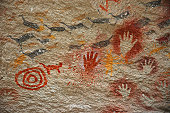Aboriginal Cave Art
Aboriginal culture dates back up to between 60,000 to 80,000 decades. The first proof of Aboriginal ethos or philosophy is evident from the still visible rock art which dates back over 20,000 years. Ochres were used to paint rocks. There’s no written speech for Australian Aboriginal People, they use symbols/icons through their art to communicate their significant cultural stories through the generations. It’s crucial to pass information to preserve their own culture. The native artwork is centred on storytelling. It’s used as a chronical to communicate the understanding of the property, events and beliefs of the Aboriginal men and women.
The purpose of symbols is just another way of composing stories of cultural significance, teaching survival and use of the property. The interpretations of the iconography differ depending on the audience.
When being told to kids, it would take on a more straightforward form highlighting the behavioural and educational aspect. There can be a mix of information and ethical teachings behind the narrative. The stories nevertheless would be translated at a different and higher level form when instructing to pioneered elders.
Although Australian Aboriginals have been using ochres as body paint, on stones and bark for almost a millennium, it wasn’t until the 1930’s the first paintings were done. These were not done in ochre or scatter art but in watercolour in the Hermannsburg mission near Alice Springs.
Traditionally paintings by Aboriginals were drawn on rock walls, ceremonial articles, as body paint and most significantly drawn in dirt or sand together with tales or songs. The art we see now on canvas and board started merely 50 years back.
Lots of folks feel that dots were used to conceal information from white guys when the Aboriginal people became fearful that they would have the ability to see and comprehend their sacred, private understanding. The dots were used to obscure the key symbols or iconography underneath.
Aboriginal art differs in style and character depending on which area the artist is from and what language is spoken. Most modern art can be recognised from the neighbourhood where it was created.
The usage for ochre paints is indicated in Arnhem Land and east Kimberley. Materials (colours) utilised for Aboriginal art was initially obtained in the local land. Ochre or iron clay pigments were used to create colours like yellow, white, red and black from charcoal. Soon other colours were added like smokey greys, sage greens and saltbush mauves. During the mid-1980’s with more Aboriginal women artists, appeared on the scene and a broader range of contemporary colours were selected, and bright desert paintings began to arrive in the marketplace. Choice of colour is still an indicator of style in several communities; Papunya Tula, part of the western desert art movement is famous for its use of soft ground colours while many other Western Desert Communities opt for strong primary colours. The styles vary dramatically even in areas, and there’s no hard rule here as can be seen in many of Papunya’s artworks that don’t necessarily comply with this thinking.
Aboriginal art has caused a revival of the culture in various ways.




